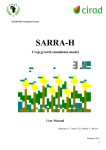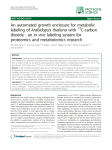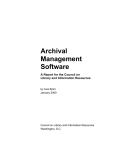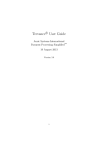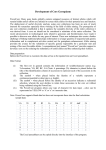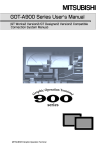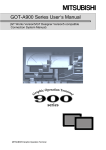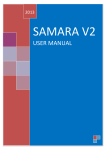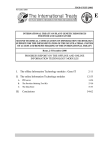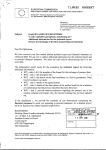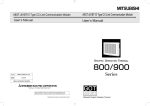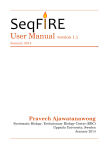Download PowerCore (v. 1.0): A program applying the advanced M strategy
Transcript
PowerCore (v. 1.0): A program applying the advanced M strategy using heuristic search for establishing core or allele mining sets User Manual Genetic Resources Division, National Institute of Agricultural Biotechnology (NIAB), Rural Development Administration (RDA), R. Korea Web site: http://genebank.rda.go.kr/powercore/ TABLE OF CONTENTS 1. OVERVIEW .................................................................................... 3 2. INSTALLATION ............................................................................. 5 3. DATA PREPARATION ................................................................ 10 4. DATA IMPORT............................................................................. 12 5. RUNNING POWERCORE............................................................ 14 6. DATA MANAGEMENT ................................................................ 20 7. RICE SAMPLE DATA .................................................................. 21 8. COMPARISON BETWEEN POWERCORE AND MSTRAT ........ 26 9. ISSUES TO BE CONSIDERED INCLUDING SNP DATA ........... 31 10. COMPLEMENTARY USES OF POWERCORE......................... 39 2 1. OVERVIEW Many genebanks globally contain untapped resources of distinct alleles which will remain hidden unless efforts are initiated to screen these alleles of its potential use and function. The deployment of useful diversity using core collections has been an area of much interests for researches especially those working in the field of allele mining. The prerequisite of any core collection established is that it captures the complete diversity of the entire collection it was derived from. A core set should not be considered a substitute of the entire collection. The recent advancements in technological tools related to genomics and bioinformatics have made it possible to discover new alleles for any gene of interest. These new techniques also create a further challenge of linking traditional phenotypic information to a larger quantity of sequential and genetic information and to complement activities carried out for germplasm enhancement. Allele mining provides the avenue for the validation of specific gene (s) responsible for a particular trait and mining of the most favorable alleles. The advent of PowerCore that implements the advance M-strategy using a modified heuristic algorithm (A*) is hoped to provide users the added ability to develop core or allele mining sets representing all alleles or classes of their observations whilst ensuring the least allelic redundancy and highly reproducible list of entries. PowerCore software uses the .NET Framework Version 1.1 environment and is freely available for the MS Windows platforms on personal computer worldwide. PowerCore is developed by C#. C# is an object oriented language which has accepted many good features of Java and C++. PowerCore runs on .NET Common Language Runtime (CLR) and can run on any platform installed with CLR. CLR is similar to Java Virtual Machine 3 of Sun Microsystems. Nowadays there are many attempts to port CLR to Macintosh and Linux. 4 2. INSTALLATION a. Download the .NET Framework Version 1.1 from the Microsoft Website (http://www.microsoft.com/downloads/details.aspx?FamilyID=262d25e3-f589-48428157-034d1e7cf3a3&DisplayLang=en) 5 b. Click ‘Run’ when prompted c. Click ‘Run’ when prompted d. A prompt for installation appears on the screen. Click ‘Yes’ e. Installation of Microsoft .NET Framework is now complete once the following dialog box appears on the screen f. The PowerCore software is now ready to be executed 6 g. For installation of PowerCore Program, open the PowerCore folder and click on the folder named ‘SETUP’ h. The following dialog box will appear on the screen. Follow the instructions provided by clicking ‘Next’ 7 i. A prompt for the Installation Folder will appear. Click ‘browse’ to select the location of the required folder j. Follow the instructions by clicking ‘Next’ when prompted for confirming installation 8 k. The installation process has begun l. Installation is now complete. Close the prompt box 9 3. DATA PREPARATION a. Before the PowerCore is executed, the data set has to be inputted into an Excel spreadsheet. Data format i. The first row in general contains the information of variable/character names (e.g. %Accession, NM1, NM2 (Note: A percentage (%) character is placed before the title of the Identification column of accessions to represent each of the accessions in the collection. ii. The symbol ~ when placed before the identity of an accession indicates a preferential selection, wherein the user decides to retain these accessions in the core set without being validated using the PowerCore. iii. The symbol ~ when placed before the identity of a variable represents a continuous/quantitative data type (e.g. height). iv. The PowerCore program allows any type of character for data input - color can be represented as YELLOW or ‘A’ or ‘a’ or a numeric data (1). (Note: PowerCore supports blank data but does not incorporate these into the final calculation). v. %Accession NM1 NM2 ~M1 ~M2 ~M3 ~A01 1 1 1 37 113 ~A02 2 1 2 31 106 ~A03 1 2 3 34 99 ~A04 3 1 2 28 113 ~A05 2 3 2 34 106 A06 1 4 1 31 113 A07 4 3 2 37 106 A08 2 1 2 31 106 A09 1 2 2 34 92 A10 3 2 3 34 99 A11 2 1 1 37 99 A12 2 1 1 37 106 A13 3 3 3 34 99 Once the data set is complete it is now ready to be used for the PowerCore program. The Excel spreadsheet can be copied directly into the interface of the program. 10 b. To run the installed program, go to the ‘START’ toolbar, and search for the PowerCore program and click ‘Open’. 11 4. DATA IMPORT a. Once the program is executed, the following window appears on the screen. Using the mouse pointer, right click on the screen. b. An additional prompt will appear – ‘Append’ function is used when new information is added to an existing file. This program has the capability to allow the input of an unlimited set of accessions or number of variables used (though the excel spreadsheet only allows limited data input). The program automatically finds/appends the new data according to the accession ID (column) and variable names (row) along with the additional information without disrupting the existing information flow (as shown below in Figures 1a and 1b). Figure 1a 12 Figure 1 b i. ii. ‘Clear and Paste’ functions are used when the existing information is replaced with a new data set. ‘Copy all’ function is used for exporting the existing data set to a Clipboard for Excel spreadsheet. (Note: PowerCore accepts various has no limit for data input size. Data input is based on the resources available in the user’s computer, and not according to the limit of the excel spreadsheet.) c. Other input sources i. Star Office Star Office windows version similar to that of Microsoft Excel. Figure 1 c 13 ii. Simple text PowerCore accepts tab separated text format. Figure 1 d 5. RUNNING POWERCORE a. The crucial step would be converting the quantitative data into classes and to validate the reliability of the data set (e.g. deleting missing/blank data). This is important as in general a continuous data set has no variables and is expressed in real numbers or in integer format. Place the mouse pointer on the top right corner of the window and click Step 1. (Figure 2) Figure 2. Display of output results for converting data into classes 14 b. Click ‘Classifying’ to create classes of each variable determined by the criterion of Sturge’s rule 1 . This will allow each accession to be allocated to these created classes. Figure 3 displays the output in the form of a histogram: Figure 3. Output in the form of a histogram c. Scrolling the scrollbar at the right side of the window allows the user to view the histogram generated for each variable. d. Histograms for quantitative variables are shaded dark blue. Histograms for continuous variables are shaded orange. The number of classes for continuous variables can be adjusted by checking the ‘User’ checkbox at the top of window and inputting the desired value. ‘Total’ indicates the total number of usermodified variables. e. By clicking the ‘Classifying’ tab, the changed values are applied. f. Place the mouse pointer on the top right corner of the window to proceed to ‘Step 2’. The following screen as shown in Figure 4 is displayed. 1 Sturge’s rule = 1 + Log2(n), n : the observed number of accessions. 15 Figure 4. Display screen for proceeding to ‘Step 2’ g. Click ‘Run’ to perform the heuristic search. By checking the ‘Random’ button, the search is performed using the random method – Accessions are selected randomly instead of being selected by the heuristic evaluation function. h. The following figure (Figure 5) shows the steps whereby the heuristic algorithm searches for the best possible accessions to be selected for the core set. Figure 5. Heuristic search • Number of Accessions-Total number of accessions from the existing collection 16 • • • • • • • • • • • • • • • j. k. Number of Variables- Represents the number of characters from the data set Non-heuristic Search-A search which does not use any heuristic algorithm (Note : Similar to random search, but results are always repetitive as search is performed sequentially) Max Possible Entries- It is the worst case scenario, wherein this is the limit for PowerCore to select the maximum number of entries. PowerCore- Number of the selected accessions using the heuristic search. Efficiency Index- Effectiveness of PowerCore in comparison to the nonheuristic search. PowerCore PowerCore or ( when ‘Sequential Entries’ is Sequencial Entries Max Possible Entries checked). (Note: A lower value signifies a more effective search) Unfilled Diversity Cells - Status during the filling of the diversity index Random Branching- Selection of nodes randomly during the selection process of same accessions with same values of minimum evaluation functions, indicating the number of its occurrence. 1 m Me − Mc × 100 MD% (Mean difference percentage) - MD% = ∑ m j =1 Mc (Me: Mean of entire collection, Mc: Mean of core collection) 1 m Rc ×100 CR% (Coincidence Rate) - CR% = ∑ m j =1 Re (Re: Range of entire collection, Rc: Range of core collection) 1 m Ve − Vc × 100 VD% (Variance Difference Percentage) - VD% = ∑ m j =1 Vc (Ve: Variance of entire collection, Vc: Variance of core collection) 1 m CVc ×100 VR% (Variable Rate) - VR% = ∑ m j =1 CVe (CVe: coefficient of variation of entire collection, CVc: coefficient of variation of core collection, m: number of traits) The left most panel on the screen are the selected entries (accessions ID as per data set) using the heuristic search. By right clicking the ‘Entry’ tab, the list could be copied to a clipboard. Figure 6 displays the output for the heuristic search completed. The panel displayed shows each variable in the form of a histogram. By right clicking the histogram, a separate table indicating the number of accession for each class, core count and the entire count is displayed. 17 Figure 6. Output for the heuristic search l. Click the ‘diversity index’ tab to display the diversity index using Nei and Shannon & Weaver calculation (Figure 7) PIC- Nei DI C Count – Core Set by Heuristic Method E Count – Entire collection Figure 7. Diversity index using Nei and Shannon & Weaver calculation 18 Figure 8. Core Collection data saved (Note: We have designed to report the probability-value of χ 2 -test for qualitative characters and the probability-value of Z-test for quantitative characters to compare the distribution of data of entire and core sets) 19 6. DATA MANAGEMENT Figure 9. Excel spreadsheet depicting the new file developed iii. iv. Once data generated for the core set is saved, a new excel sheet is generated by the PowerCore. Filtering of the core set from the entire collection is done, and the core set is automatically marked ‘Y’ by the software. Figure 10. Filtering step for the core set v. The results can then be saved in a separate worksheet in the excel spreadsheet. 20 Figure 11. Complete accession level detail of core set generated via PowerCore 7. RICE SAMPLE DATA a. Application of PowerCore on phenotypic data For actual implementation of the software, a real data set using 1000 phenotypic data for rice was tested. i. The file titled ‘Phenotypic_Dataset_for_PowerCore.xls’ is opened and the Data tab is clicked. Figure 12. Screen capture of worksheet indicating the phenotypic data for 1000 rice accessions 21 ii. All data is selected and copied to the clipboard. Figure 13. Data is copied to clipboard by right-clicking the mouse and selecting the ‘Copy’ option iii. The PowerCore is first launched using the ‘Start menu’, before data is pasted using the ‘Clear and Paste’ function by right-clicking the mouse. Figure 14. Phenotype data is pasted unto the clipboard by right-clicking the mouse and selecting the desired function 22 Figure 15. Screen capture of the attached phenotypic data using PowerCore iv. Click the ‘Step1’ and ‘Classifying’ tabs. Figure 16. Screen capture once classifying is performed 23 v. Click ‘Step2’ and click ‘Run’. Figure 17. Filling of the diversity panel Figure 18. Screen capture indicating the completion of the selection process for entries into the core set using PowerCore 24 b. Application of PowerCore on genotypic data The PowerCore is next tested using a set consisting 1000 SSR data for rice, whereby the file ‘SSR_Dataset_for_PowerCore.xls’ is used and the Data tab is clicked open. Figure 19. Screen capture of the SSR data set Figure 20. Result display of analysis by PowerCore for SSR data 25 c. Results of a and b. Table 1. Number of accessions selected by PowerCore Experiments Number of accessions in core collection (ratio against entire) 1000 phenotype 45 (4.5%) 1000 SSR 87 (8.7%) (Note: Detailed results of 1000 phenotype and 1000 SSR ‘Results_for_Phenotypic_Dataset.xls’ and ‘Results_for_SSR_Dataset.xls’. ) data sets are provided in 8. COMPARISON BETWEEN POWERCORE AND MSTRAT 8.1 Using virtual accessions Using 1000 virtual accessions, a comparison was done between the PowerCore and MSTRAT. The quantitative characters (B001, B002 and B003) of the virtual accessions were designed into three types of distributions as shown in Figure 21. It was noted that B001 was biased to left side and represented the extreme value. B002 had a normal distribution and B003 had a double peak. B001 B002 700 300 600 250 B003 350 300 250 500 200 200 400 150 150 200 100 100 100 50 300 50 150-160 140-150 130-140 120-130 110-120 100-110 80-90 90-100 70-80 60-70 70-75 65-70 60-65 55-60 50-55 45-50 40-45 35-40 30-35 25-30 20-25 15-20 10-15 80-90 90-100 70-80 60-70 50-60 40-50 30-40 20-30 0-10 10-20 0 50-60 0 0 Figure 21. Three types of distributions for the quantitative characters in virtual accessions a. PowerCore All default options were used in PowerCore. PowerCore resulted in 18 accessions being selected for the core set. b. MSTRAT A minimal optimum size of 34 entries for the core set was selected by MSTRAT. MSTRAT is strongly guided by its ‘Redundance’ function. To obtain the core sets using MSTRAT, two experiments were conducted. In the first experiment the core value was set at 18 (value of which is similar to that provided by PowerCore). For the second experiment, the core value was set at 34 (result of which was obtained using MSTRAT’s 26 ‘Redundance’ function). For both experiments, the values set for the ‘Redundance’ function was as follows: 50 repetitions, 100 iterations and the other options were set as default. c. Results of PowerCore and MSTRAT Results obtained are as shown in Table 2. (Important note: PowerCore retains all classes in the Core Collection) Table 2. Results of the comparison between PowerCore and MSTRAT Variables Class Entire Count Core Count PowerCore A001 A002 A003 A004 MSTRAT_34 1 781 10 8 21 2 176 3 6 8 3 35 2 2 3 4 7 2 1 1 5 1 1 1 1 1 2 1 1 1 2 2 1 1 2 3 995 15 15 30 1 56 3 3 4 2 768 8 7 19 3 171 5 5 7 4 2 1 1 2 5 2 1 1 1 1 995 15 15 30 2 1 1 1 1 3 1 1 1 1 4 B001 MSTRAT_18 3 1 1 2 3.00 ~ 11.73 722 8 12 24 11.73 ~ 20.45 248 7 5 8 20.45 ~ 29.18 26 1 - 1 29.18 ~ 37.91 1 1 - - 1 1 - - 10.00 ~ 15.73 5 1 1 1 15.73 ~ 21.45 17 2 - - 21.45 ~ 27.18 64 1 2 4 37.91 ~ 46.64 46.64 ~ 55.36 55.36 ~ 64.09 64.09 ~ 72.82 72.82 ~ 81.55 81.55 ~ 90.27 90.27 ~ 99.00 B002 27 B003 27.18 ~ 32.91 121 3 1 5 32.91 ~ 38.64 251 3 5 7 38.64 ~ 44.36 281 2 4 7 44.36 ~ 50.09 194 2 3 7 50.09 ~ 55.82 49 1 1 2 55.82 ~ 61.55 15 1 - - 61.55 ~ 67.27 2 1 1 1 67.27 ~ 73.00 1 1 - - 59.00 ~ 67.82 10 1 - - 67.82 ~ 76.64 29 1 1 1 76.64 ~ 85.45 35 2 2 3 85.45 ~ 94.27 12 1 - - 94.27 ~ 103.09 255 3 7 7 103.09 ~ 111.91 171 1 1 4 111.91 ~ 120.73 163 3 3 10 120.73 ~ 129.55 237 2 2 4 129.55 ~ 138.36 84 2 1 4 138.36 ~ 147.18 3 1 1 1 147.18 ~ 156.00 1 1 - - (Note: Detailed results are in ‘Results_ for_ Virtual_1000.xls’ file) 8.2 Using the real rice phenotype data set of 1,000 accessions (39 phenotype variables consisting of 28 qualitative and 11 quantitative characters) To compare the selecting efficiency of PowerCore with the conventional core collection methods using 39 phenotype traits, 10% core subsets (100 accessions for each core set) were developed using the strategy of the Random core collection (R-Core) and the Proportional core collection (P-Core) in the following steps. The quantitative characters of the entire collection were standardized using Z-score while qualitative characters were used as encoded. Classification analysis was done using the Two-Step classification method of the SPSS 13.0 program (SPSS Inc 2004). Seven clusters were determined and entries were randomly selected using the criteria of the proportional number of each cluster for developing the P-core. The R-core was developed after random sampling of the entire collection. We have also compared the efficiency of PowerCore with MSTRAT which was recently developed for increasing the diversity of sub-core sets. The same comparison conditions of same number of entries (45 accessions) were used since PowerCore selected 45 accessions to fill all diversity cells (alleles and intervals of entire collection). Default parameters (3 for replicates; 30 for maximum iterations) were applied for MSTRAT to run the rice data set. 28 In the comparison of selecting efficiency using the coverage rate m ( Coverage (%) = 1 ∑ Dc × 100 , where Dc is number of classes occupied in core m j =1 De collection and De is number of classes occupied in entire accessions in each character and m is the number of variables). The core sets, developed using PowerCore, showed 100% coverage of variables without any deviations, indicating the highest selecting efficiency in all the phenotype characters. This suggests PowerCore maintains all the diversity present in each class. Table 3. Comparison of selecting efficiency of PowerCore with the conventional core collection methods using the real rice phenotype data set of 1,000 accessions Variables VG BP BC BLSC LA FLA LC CC AuriC CA IC CS PT SB PE AP ApiC SC LPC SLC SLL SCC ET LB BLB RSB LS S SH Coverage (%) R 80.0 33.3 80.0 50.0 100.0 100.0 66.7 66.7 100.0 100.0 66.7 100.0 100.0 50.0 60.0 100.0 100.0 100.0 60.0 100.0 33.3 40.0 100.0 100.0 60.0 100.0 66.7 60.0 81.8 P 60.0 33.3 80.0 50.0 100.0 100.0 66.7 66.7 100.0 100.0 100.0 100.0 100.0 50.0 100.0 80.0 100.0 100.0 60.0 100.0 33.3 60.0 100.0 100.0 40.0 100.0 66.7 80.0 72.7 MSTRAT 80.0 100.0 100.0 100.0 100.0 100.0 100.0 66.7 100.0 100.0 100.0 100.0 100.0 100.0 100.0 100.0 100.0 100.0 100.0 100.0 100.0 100.0 100.0 100.0 80.0 100.0 100.0 100.0 90.9 PowerCore 100.0 100.0 100.0 100.0 100.0 100.0 100.0 100.0 100.0 100.0 100.0 100.0 100.0 100.0 100.0 100.0 100.0 100.0 100.0 100.0 100.0 100.0 100.0 100.0 100.0 100.0 100.0 100.0 100.0 29 BL 81.8 63.6 90.9 100.0 BW LL NDSH CL CN PL GL GW W1000 88.9 60.0 63.6 81.8 60.0 63.6 75.0 66.7 63.6 66.7 60.0 81.8 72.7 60.0 72.7 75.0 33.3 54.5 77.8 90.0 100.0 100.0 80.0 100.0 75.0 66.7 100.0 100.0 100.0 100.0 100.0 100.0 100.0 100.0 100.0 100.0 Coverage 75.9 75.4 94.8 100.0 (NOTE: 28 qualitative characters- VG(Variety group), BP(Blade pubescence), BC(Blade color), BLSC(Basal leaf sheath color), LA(Leaf angle), FLA(Flag leaf angle), LC(Ligule color), CC(Collar color), AuriC(Auricle color), CA(Culm angle), IC(Internode color), CS(Culm strength), PT(Panicle type), SB(Secondary branching), PE(Panicle exsertion), AP(Awn presence), ApiC(Apiculus color), SC(Stigma color), LPC(Lemman and Palea color), SLC(Sterile Lemma color), SLL(Sterile Lemma length), SCC(Seed coat color), ET(Endosperm type), LB(Leaf blast), BLB(Bacterial leaf blast (Xanthomonas oryzae), RSB(Striped Rice Borer), LS(Leaf senescence), S(Shattering); 11 quantitative characters- SH(Seedling height), BL(Blade length), BW(Blade width), LL(Ligule length), NDSH(Number of days from seedling date to 50% heading), CL(Culm length), CN(Culm number), PL(Panicle length), GL(Grain length), GW(Grain width), 1000W(1000-grain weight). 8.3 Using the real rice genomic SSR data set of 1,000 accessions (18 loci) To compare the selecting efficiency of PowerCore with the conventional core collection methods, the genomic data of 12 loci of SSRs were used. We have selected 100 accessions (10% of entire collection) for the core sets of R-core and P- core and 87 accessions for MSTRAT since PowerCore retained 100% coverage with 87 selected entries. As shown in the phenotype data, PowerCore always retains 100 % of coverage rates in all the loci tested. PowerCore was designed to fill all diversity cells (all alleles of SSR loci), so it selects entries until a core set satisfy 100 % of coverage in all the cases. Table 4. Comparison of selecting efficiency for PowerCore with the conventional core collection methods using the real rice SSR data set of 1,000 accessions Variables iRM21_1 iRM44_1 iRM48_1 iRM206_1 iRM214_1 Coverage Rate (%) R 45.5 42.1 35.0 45.0 36.8 P 54.5 57.9 75.0 40.0 57.9 MSTRAT 100.0 73.7 80.0 82.5 84.2 PowerCore 100.0 100.0 100.0 100.0 100.0 30 iRM228_1 50.0 42.9 92.9 100.0 iRM231_1 iRM232_1 iRM235_1 iRM241_1 iRM246_1 iRM247_1 iRM249_1 iRM253_1 iRM257_1 iSBE_1 iSSS_1 iGBSS_1 66.7 50.0 47.4 45.5 77.8 45.8 25.0 46.2 48.1 36.4 44.4 54.5 55.6 64.3 31.6 50.0 66.7 45.8 50.0 69.2 44.4 54.5 66.7 63.6 100.0 100.0 78.9 81.8 100.0 95.8 85.0 100.0 92.6 72.7 88.9 90.9 100.0 100.0 100.0 100.0 100.0 100.0 100.0 100.0 100.0 100.0 100.0 100.0 Coverage 46.8 55.0 88.9 100.0 9. ISSUES TO BE CONSIDERED INCLUDING SNP DATA a. Preferential Selection PowerCore has the ability to allow preferential selection to be performed by the user. Preferential selection can be performed when the user decides on including pre-existing entries from a present core into the new core to be developed by PowerCore without being validated. Some reasons for preferential selection may include that these accessions possess traits of interest to the user or that these accessions are considered as standard reference materials which are needed to be included. As explained earlier in section 3, the symbol ‘~’ is placed where necessary. PowerCore firstly automatically selects accessions marked ‘~’ to fill the diversity cells before selecting the rest of the accessions using its heuristic estimation. To demonstrate this function, we are providing the results using the same data with the function of preferential selection. Table 5. Results of the comparison between PowerCore and MSTRAT without preferential selection %Accession NM1 NM2 ~M1 ~M2 ~M3 A01 1 1 1 37 113 A02 2 1 2 31 106 A03 1 2 3 34 99 A04 3 1 2 28 113 A05 2 3 2 34 106 31 A06 1 4 1 31 113 A07 4 3 2 37 106 A08 2 1 2 31 106 A09 1 2 2 34 92 A10 3 2 3 34 99 A11 2 1 1 37 99 A12 2 1 1 37 106 A13 3 3 3 34 99 A14 1 2 2 31 92 A15 3 1 1 34 85 A16 2 2 2 31 113 A17 1 2 3 34 99 A18 3 3 2 31 113 This data is used without any alteration to it. Results obtained using PowerCore indicate that 7 entries were selected (Figure 22). Figure 22. Results of PowerCore using data without preferential selection The next step would be the modification of the same data by placing ‘~’ to names of certain accessions (marked in red) to indicate preferential selection. This modified data is then re-validated using PowerCore. 32 Table 6. Modified data for preferential selection %Accession NM1 NM2 ~M1 ~M2 ~M3 A01 1 1 1 37 113 ~A02 2 1 2 31 106 A03 1 2 3 34 99 A04 3 1 2 28 113 ~A05 2 3 2 34 106 ~A06 1 4 1 31 113 A07 4 3 2 37 106 A08 2 1 2 31 106 A09 1 2 2 34 92 A10 3 2 3 34 99 A11 2 1 1 37 99 A12 2 1 1 37 106 ~A13 3 3 3 34 99 A14 1 2 2 31 92 ~A15 3 1 1 34 85 A16 2 2 2 31 113 A17 1 2 3 34 99 A18 3 3 2 31 113 As shown in Figure 23, the accessions marked with ‘~’ are automatically selected into the core set developed though the number of entries in the new core set has increased. 33 Figure 23. Results of PowerCore using the same data for preferential selection b. Dealing with null values using PowerCore One of the important features of the PowerCore is that it takes into account the uniqueness in the value of an accession for each character during the filling of the diversity cells. The heuristic functions of the PowerCore have been designed to ensure no handicaps are caused by a null value of a character. Missing values are often common in raw data sets. However these values (whether missing or null) are also considered as suitable candidates for the core set when validated with PowerCore. c. The influence of the number of classes and characters to the number of entries in the core set developed i. Number of classes PowerCore creates the number of classes for any quantitative character as a default value based on Sturge’s rule (mentioned earlier in section 5). The number of classes for any quantitative character can be adjusted in PowerCore. Increasing the number of classes in a quantitative character gives more weight to the particular character. The increase in the number of classes leads to more accessions being selected to fill in the range. 34 Figure 24. An example illustrating the adjustment in the number of classes ii. The number of characters It is important to note that the PowerCore selects entries for the core set based on only given characters. Diversity is covered within these given characters. Thus, more characters create more diversity cells which must be filled. Increase in the number of characters leads to an increase in the number of entries to be selected for the core set. A modified data set of the original 1000 virtual accessions was created by reducing the number of characters (A001, A002, B001, B002) and this was used to run with PowerCore. As a result, the number of entries for the core set decreased to only 14 (Figure 25) as compared to 18 from the original results gained in section 8. Figure 25. Results attained when characters (A001, A002, B001 and B002) of the 1000 virtual accessions are reduced. 35 c. How to prepare the data sheet for SNP data With the understanding that large scaled SNP data are rarely available in seed banks so far, PowerCore was designed for better application of fragment polymorphic data like SSRs. However, PowerCore does accommodate SNP data through the recording of SNP and Indel variations among accessions applied. Once the SNP or Indel genotype data of analyzed accessions is recorded to an Excel worksheet or a text file, PowerCore accepts those as qualitative data. The rest of the processes are same with that of qualitative data. Exon-10 start SNP- Figure 26. Screenshot after aligning the sequences of particular genes to find and score SNP or Indel variations Till date, we do not have SNP data of large collections. We used the virtual data set to demonstrate the application of PowerCore using SNP data. As mentioned above, 36 PowerCore accepts any form of qualitative data and we used the data sheet shown Figure 27. So each sequence variations is treated as SNP or Indel loci and subjected to PowerCore for implementing selection of a core set until filling all diversity cells using the given data. Improvements will be made for PowerCore to be more compatible with genomic data to meet future needs. Figure 27. Screenshot indicating how to record SNP or Indel data using an Excel worksheet 37 Figure 28. Results of PowerCore using sample SNP data PowerCore can accept each SNP genotype as a qualitative character while also accepting the combination of letters representing DNA sequences. Heterozygous genotype can be recorded with a separator like ‘/’. However, we are recommending the users to record these heterozygote genotype to one form of C/A or A/C in the case where we have ‘A/C’or ‘C/A’ sequence variation on the specific SNP locus. If you use both, PowerCore recognize both to be different alleles. As for recording Indel alleles, we are recommending to use ‘O’. If we leave deletion alleles as ‘blank’, PowerCore will ignore those. So please use ‘O’. 38 10. COMPLEMENTARY USES OF POWERCORE 10.1. Complementary use for selecting entries from the sub-groups when clustering is performed using the conventional methods A major challenge for a user in the selection of entries from a cluster developed using the conventional methods would be choosing those that capture the entire diversity of the cluster itself and possessing unique alleles for the core set. Certain users may also want to maintain the genetic clusters of their entire collection and develop core sets for their specific purposes. Sometimes, these are required for the improvement of an existing core set. For both cases, PowerCore can be used in combination with conventional clustering tools. This process can be easily undertaken using PowerCore while maximum diversity is maintained in the core sets generated. To include entries from a pre-existing core set, a ‘~’ is placed before their accession names, before other entries are selected to cover all alleles/diversity existing in the entire collection. 10.2 Retaining related accessions for specific purposes, e.g. for association analysis Some users require retaining related accessions with particular variations to search for relationships between traits and genes. To cater this, the user can firstly select these entries using the conventional tools like clustering analysis. A ‘~’ is then placed before the accession name before running PowerCore to fill-in the diversity cells with the preselected accessions first. PowerCore provides the user with the least number of entries, while retaining the related accessions and other distant accessions simultaneously. 10.3 Other applications of PowerCore in genetic resources and breeding programs In addition to developing cores sets, PowerCore is also very useful in selecting diverse sets for improvement of breeding programs in a minimal time. Some researchers handle large quantity of breeding materials (in certain cases, several thousand lines) e.g. Near Inbred Lines (NILs). Developing a short listing of these lines for intensive investigation such as DNA sequencing or SNP genotyping of specific genes may be cumbersome using conventional methods. PowerCore provides a quick solution to this. Another point to note is the ability of PowerCore to develop extremely distant sets from an existing reference set. As explained in earlier examples, the ‘~’ is placed before the names of accessions from the reference set before running the PowerCore which effectively differentiates the reference set from the final list. 39








































